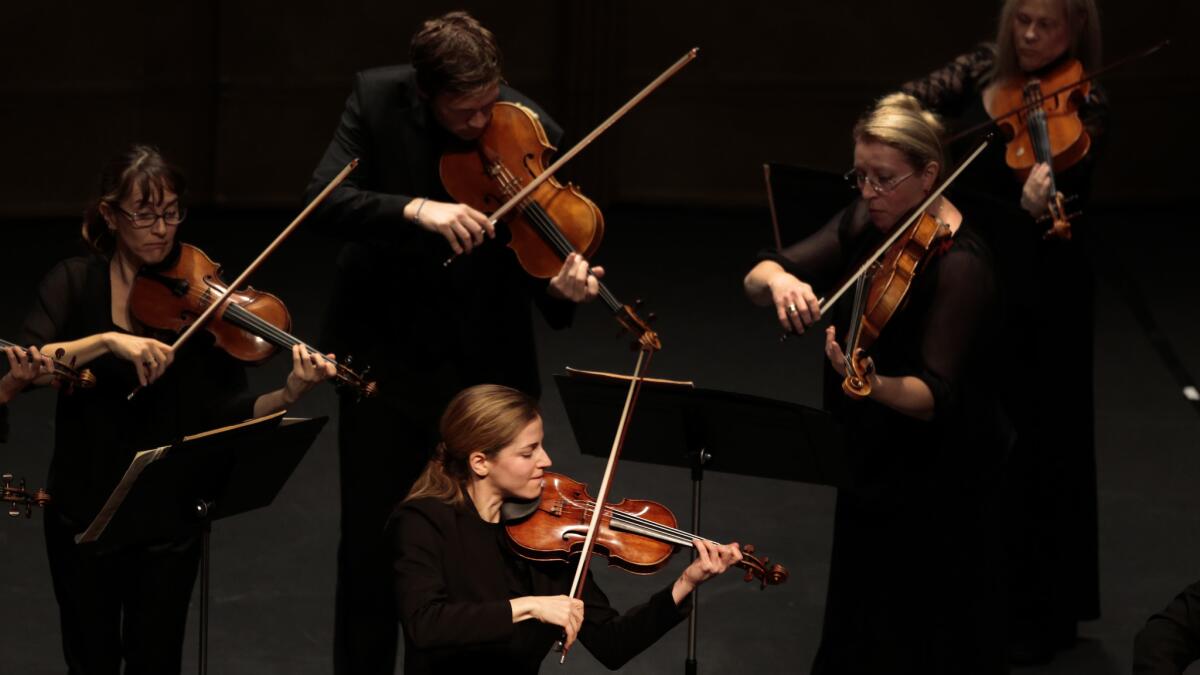Review: Make this L.A. Chamber Orchestra guest conductor feel at home

- Share via
With Jeffrey Kahane having announced that he will step down as music director of the Los Angeles Chamber Orchestra in 2017, it is safe to assume that any guest conductor is a candidate for the position. There’s time. The search will likely be long and extensive.
Then again, LACO could make life easy for itself.
Karina Canellakis’ debut with the orchestra was over the weekend. I heard her at UCLA’s Royce Hall Sunday night. In the old days, when cigar-chomping autocrats ran orchestras and couldn’t care less about boards or committees, they simply signed as they saw fit. Canellakis is an astonishing musician. If this were the old days, she would already have a contract.
But she is also the model of a modern musician, one that would never have existed in the conventional old days.
As a young New York violinist fresh out of conservatory, she auditioned six years ago for an opening in the LACO violin section, and she was enthusiastically accepted. Kahane told me at intermission Sunday that she blew him away.
But she never took the job. Apparently the conducting bug had hit. A New Yorker (who is cagey about giving out her age), she began performing as both violinist and conductor of the International Contemporary Ensemble, the outstanding New York new music group.
This season she began as assistant conductor of the Dallas Symphony. In October, she stepped in at the last minute for music director Jaap van Zweden, who had a shoulder injury, and conducted a performance of Shostakovich’s demanding Eighth Symphony that made Dallas Morning News music critic Scott Cantrell’s top 10 list last month.
For her LACO program, Canellakis appeared as violinist and conductor and as advocate for music new, ancient and in between. At first, you hardly knew she was a conductor or quite what she stood for.
The concert began with Vivaldi’s “La Tempesta di Mare,” a stormy concerto for violin and strings. She had the LACO strings stand, and she stood among them. Beyond giving the upbeat for each movement, she did no overt conducting, treating this as chamber music.
However, she inspired extremely crisp rhythms. Her tone mimicked the wiry quality of a period gut-string violin. The outer movements, which in Vivaldi suggest storm at sea, were scintillating, and the calm inner movement was gleamingly still. It was a fine performance, but there are many fine young violinists who could probably equal it.
Peteris Vasks’ “Lonely Angel” followed. The Latvian composer calls his short solo for violin and strings from 2006 a meditation. The program note suggested that the long, arching solo may be meant as the voice of an angel. Vasks, though, is not a sentimental composer. His music is dark, depressing, mournful and deeply beautiful in its spiritually gloom-ridden way.
Here Canellakis’ tone changed to something fuller. The strings that accompanied provided little more than harmonic cushion with soft tremolos and a rich supporting base line. Again, the performance was pure chamber music. Canellakis’ solo sang eloquently. She gave the U.S. premiere of the score in Toledo last year.
Then, with the strings still standing, Canellakis conducted John Adams’ early “Shaker Loops.” She did not use a baton, but at times her hands seemed more like two thumbs and eight slender batons. She has a contagious command of rhythm, which she signals through her whole body. When she gets into it, she looks like a jockey riding the orchestra as though it were a spirited bronco and having a wonderful time doing so.
The details, shaking strings, swooping inner lines, chugging Minimalist beats all had extraordinary vitality. There was no instant, no detail that didn’t come to life.
After intermission Canellakis did pick up a baton for Schubert’s Fifth Symphony, and the full chamber orchestra was seated. Her break with tradition, though, was to place the woodwinds at the front of the orchestra, which created a lovely effect. Once more, Canellakis’ performance was brisk, propulsive and exquisitely detailed. She shaped Schubertian melody lovingly. This is a youthful symphony and she let it sound youthful.
But the Fifth also happens to Schubert at his most conventional, here mimicking what was already an old-fashioned “Classical” symphony in 1816. There isn’t all that much a conductor can do with it, which at moments appeared to frustrate Canellakis, causing her to push a little too hard.
Despite its advantages, the seating arrangement wasn’t ideal in all ways. The horns were seated behind the strings where you couldn’t see them. An acoustical (and psycho-acoustic) rule of thumb is that when you can’t see, some sound is blocked. Risers would have helped. The bass was also back against the rear of the shell where his sound was also muddier than it would have been had he been standing further forward.
These are minor things. Canellakis clearly needs to be heard in meatier repertory, past and present. But this was an exceptional debut. When she gestured the orchestra to rise after the Schubert, the players remained seated in a rare tribute to a young conductor making her debut.
Remember her name. If LACO doesn’t grab her, some other orchestra eager to embrace the future will. And likely soon.
Twitter: @markswed
More to Read
The biggest entertainment stories
Get our big stories about Hollywood, film, television, music, arts, culture and more right in your inbox as soon as they publish.
You may occasionally receive promotional content from the Los Angeles Times.











